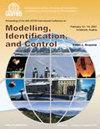弹簧加载、电缆驱动、可穿戴上肢外骨骼的建模与设计
IF 0.9
4区 计算机科学
Q4 AUTOMATION & CONTROL SYSTEMS
引用次数: 34
摘要
本文提出了一种基于外骨骼仿真和人体模型的可穿戴外骨骼设计方法。新方法解决了物理人外骨骼相互作用的问题,模型和模拟了外骨骼和人体的力学,这使得设计师能够有效地分析和评估外骨骼设计的功能与人体的协调一致。将人体生物力学模型与外骨骼模型相结合,开发了仿真平台。根据提出的方法,外骨骼被设计用于帮助神经肌肉损伤的患者。最后给出了分析和优化的结果。本文章由计算机程序翻译,如有差异,请以英文原文为准。
Modeling and Design of a Spring-loaded, Cable-driven, Wearable Exoskeleton for the Upper Extremity
An approach to the design of wearable exoskeletons on the basis of simulation of the exoskeleton and a human body model is proposed in this paper. The new approach, addressing the problem of physical human-exoskeleton interactions, models and simulates the mechanics of both the exoskeleton and the human body, which allows designers to eectively analyze and evaluate an exoskeleton design for their function in concert with the human body. A simulation platform is developed by integrating a biomechanical model of the human body and the exoskeleton. With the proposed approach, an exoskeleton is designed for assisting patients with neuromuscular injuries. Results of the analysis and optimization are included.
求助全文
通过发布文献求助,成功后即可免费获取论文全文。
去求助
来源期刊

Modeling Identification and Control
工程技术-计算机:控制论
CiteScore
3.30
自引率
0.00%
发文量
6
审稿时长
>12 weeks
期刊介绍:
The aim of MIC is to present Nordic research activities in the field of modeling, identification and control to the international scientific community. Historically, the articles published in MIC presented the results of research carried out in Norway, or sponsored primarily by a Norwegian institution. Since 2009 the journal also accepts papers from the other Nordic countries.
 求助内容:
求助内容: 应助结果提醒方式:
应助结果提醒方式:


